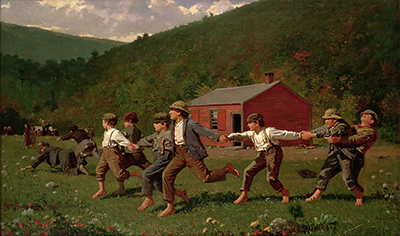The great American painter and printmaker, Winslow Homer occupies a prized place in the pantheon of American artists.
This nineteenth-century painter is probably best known for his tempestuous seascapes, bright watercolour landscapes, illustrations of soldiers during the Civil War, portraits of laborers during the Reconstruction era and scenes of the American northeast coastal areas. Perhaps Homer's most beloved and popular works was Snap the Whip. Completed in 1972, Snap the Whip is an oil on canvas painting that measures 56 cm by 91.4 cm (22 in by 36.0 in). The painting depicts a scene of boys playing outside a rural schoolhouse.
Capturing the Innocence of a Reborn America
The American painter was among the many artists of the nineteenth century who tried to capture the innocence and America's post-Civil War future. He reminisces about the simplicity of rural life and reflects on the hardships people face following the Civil War. The painting also evokes feelings of nostalgia for the country's simplicity of rural agrarian that Americans were starting to leave behind as they moved to cities in the post-Civil war era.
Homer's painting depicts nine children playing the age-old game, Snap the Whip in front of a small red schoolhouse. In the foreground is a grassy field with wildflowers and a hillscape background. The boys, barefoot and dressed in rustic clothes, are pulling and tugging each other which sends two boys on the far right of the line flying to the ground.
The blue sky is graced with fluffy white clouds in the painting and the soft glow of sunlight radiating from the clouds illuminates the children’s faces. Their rustic clothes, especially their suspenders, short pants, and caps, depict the real 1800 American dress code. In the distance are two school teachers who are most likely supervising the normal recess activity.
Symbolism
The kids are playing barefoot which symbolizes their freedom, however, their suspenders are linked to the responsibilities of manhood. When observed from right to left, the kids in the painting try to stay connected, run in harmony, and fall portraying all the possible scenarios for Americans post-Civil War.
Winslow Homer did another version of the painting. It was a smaller version of the original painting and replaces the hilly background with a wide, blue sky. This version now hangs on the walls of the Metropolitan Museum of Art. Snap the Wind was a huge success for Homer and so many artists have reproduced it.




